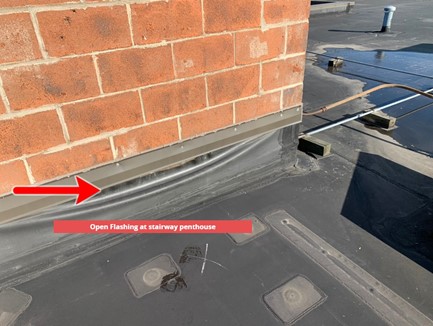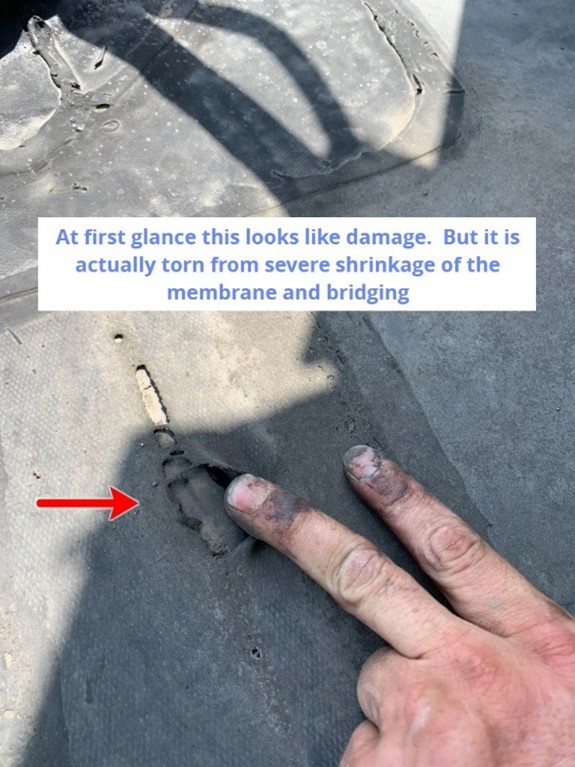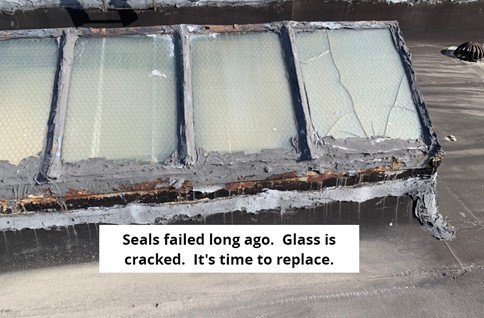Philosophers have long asked, “if a tree falls in the forest and no one is there to hear it, does it make a sound?” At Reliable Roofing, we say, “That’s not the correct question!” The correct questions is: Did that tree damage the roof membrane?
Flat roofs (a/k/a “low sloped roofs”) are more prone to leaks than steep-sloped roofs. This is perhaps the worst kept secret in real estate. A flat roof is not designed with a path for water to run off quickly, which allows moisture to collect on the surface. On that already vulnerable surface, there are certain parts of a flat roof which are more vulnerable to leaks than other areas. These areas include roof top HVAC units, plumbing stacks, other penetrations and parapet walls.
Maintaining a Flat Roof
Installing a flat roof is straight-forward in principle: make sure every seam and penetration is sealed tight. However, maintaining the flat roof so that it remains water-tight requires regular attention and care. Routine roof inspections are necessary to diagnose wear and damage so that building owners conduct prompt repairs before minor issues turn into water damage. All major roof manufacturers require a routine maintenance program in order to maintain their roof system warranty in good standing.
Sun, rain, snow, freezing, thawing and wind stress your commercial, multi-family or industrial roof 24/7/365. Weather-related wear and tear is a reality. Human activity, such as building maintenance, can also damage roofs. At some point, a flat roof, too, will leak. Rainwater that collects on the flat roof will infiltrate seams or tears. This could lead to water being absorbed in the roofing substrate, such as insulation board or roof-deck panels. Ultimately, this infiltration may result in a visible leak on the interior of the building.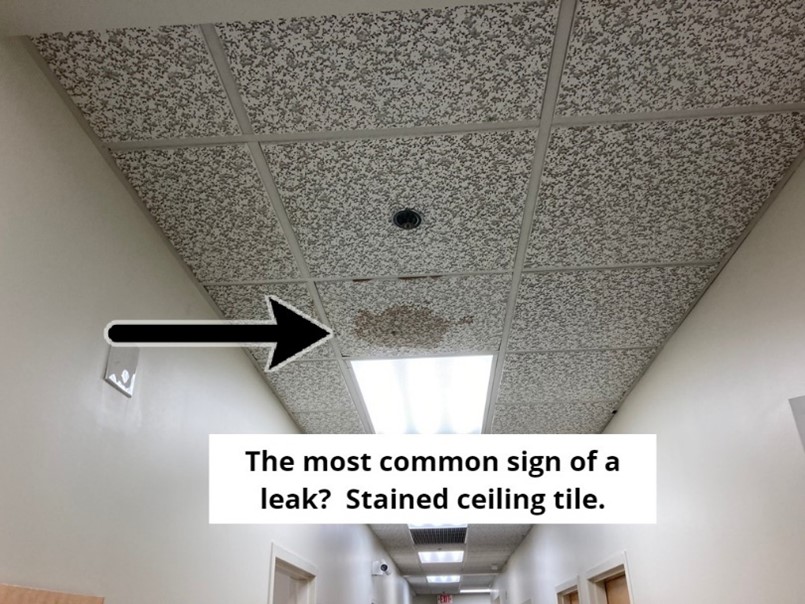
What are the vulnerable areas of a low-sloped roof?
Building managers who suspect a roof leak may notice discolored spots on the ceiling. Bubbling in the wall paint, which is another sign of a leaky roof, may occur over a period of years as moisture trickles from the roof and seeps into the walls. Mold growth may also be visible. But early detection is best. Here is our list of the most common warning signs for flat roofs.
1. Damaged Roofing Membranes
There are 3 leading roof membrane types in the USA: modified bitumen, EPDM Rubber, and thermoplastics such as TPO or PVC. The membrane bears the brunt of humans and nature during its lifetime. The roofing membrane can become damaged over time.
Membranes can crack, blister and split. As a result of the damage, water accumulates beneath the membrane. The roof insulation will become waterlogged, and the cause of the leak will be difficult to identify. Regular inspections of the roof membrane are key to leak prevention.
2. Open or Damaged Flashing
Flashing is best known as roofing material which runs vertically. A wide range of structures penetrate through the rooftop surface and must be “flashed” with compatible roofing products. These structures include plumbing vents, gas lines, pipes, ductwork, HVAC units and other building components. Any area with rooftop penetrations is susceptible to leaks.
Flashings must be kept sealed. Over time, they may fail and open up. Worn or damaged flashings compete with damage from humans as the number 1 cause of roof leaks. Flashings should be checked at least twice per year.
3. Blisters or “bridging” in the Roof Membrane
Flat roof membranes are prone to blistering and “bridging”. Blisters look like bubbles forming under the roof membrane. Over time, the adhesive lets go and the expansion and contraction of the membrane leads to a bubble or wrinkle formation. This is a sign that the membrane is nearing the end of its useful life. Bridging is the shrinking of the membrane that leads to stress on the seams, and flashings. Bridging can be pronounced in EPDM membranes as they age. Bridging and blistering can lead to cracks in the membrane. EPDM membrane will literally tear itself apart over time if left alone.
4. Skylights
Skylights are big-time leakers. Over time, their seals wear out. The skylight lens is also vulnerable to damage from debris. Finally, all too often, they are installed without saddles up-slope from their curb. (A saddle diverts water around a protrusion such as a skylight.) Skylights should be checked regularly and most should be replaced when the frames is damaged or the seals are visibly worn.
5. Debris
Like a nail through your car’s tire, a nail or other piece of debris can puncture your roof membrane. Check near mechanical units and under trees. For example, upon noticing a broken tree branch on the roof, remove the debris and examine the rooftop for areas where the branch may have gouged the roof surface.
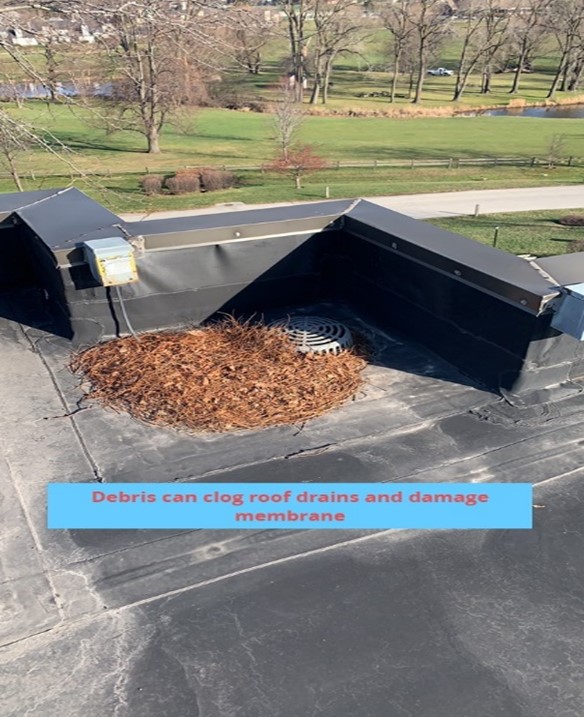
6. Ponding
Areas that display ponding should be closely examined. A certain amount of ponding is excepted. However, when rainwater remains on the roof for more than 48 hours after precipitation when drying conditions are reasonable, that kind of ponding needs close monitoring. The longer the water stays on the flat roof, the more likely leaks will appear. Aging flat roofs are especially susceptible to ponding.
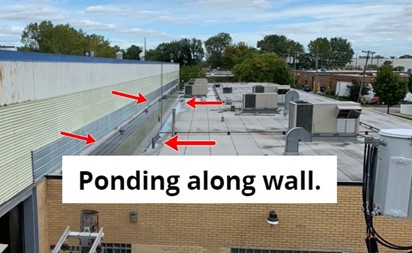
Work with a Professional Roofer for Routine Maintenance and Repairs
Ponding is often the result of and underlying structural issue or compressed substrate boards. Ponding is sometimes easily fixed. In other cases, ponding may signal the needs for extensive repairs or even a roof replacement.
Manufacturer details are specific about proper membrane repair. Reliable Roofing is Chicagoland’s most trusted commercial roofing contractor. We provide high-quality roofing services to businesses, condo associations and apartment buildings in the Chicago area. We are experts are routine inspections and repairs. Whether the repair is simple or complicated, large or small, Reliable Roofing can help.
We service a wide range of commercial roof types and serve all businesses, apartment buildings and condo associations. Our roofing crews are experienced in servicing metal roofs, modified bitumen roofs, single-ply EPDM roofs and single-ply TPO and PVC roofs. Plus, Reliable Roofing is bonded, licensed and insured for up to $6 million.
 We support our Troops, Police & Freedoms
We support our Troops, Police & Freedoms

